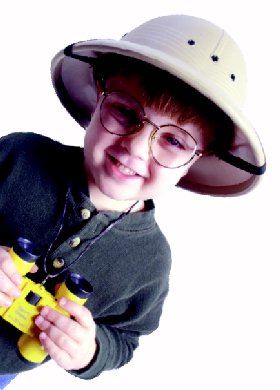|
|
|||
|
|
|
|
|
|
|
|||
|
|
|
|
|


Register Now for Summer CampWant the kids to have fun this summer? Let them dive into natureís treasure chest at Camp Earth, where children ages 4-12 have fun and learn by using the museumís vast resources.Itís an experience you wonít find anywhere else! Kids investigate the Earth through behind-the-scenes tours, hands-on encounters and experiments that can only happen at Carnegie Museum of Natural History. Week-long summer camps run June 14 through August 20 and feature age-appropriate topics like Beach Buddies; No Bones About It; Ocean Commotion; Phamous Pharaohs; Raising a Tipi; Shake, Rattle and Roll; and more. There are even camps focusing on Beakmanís World, the museumís summertime exhibit where kids work in this TV scientistís wacky lab. There are camps that travel to Phipps Conservatory and Carnegie Museum of Art, and one that includes a trip on the Voyager, the floating science classroom docked near Carnegie Science Center. Outdoor experiences are part of all camps too. Some groups may go outside to see how much space a dinosaur would cover, and others may go out to collect rocks and plants. After eating a brown-bag lunch, campers go outdoors where games are part of the fun. Half-day camps are planned for children ages 4 and 5, camps for ages 6-10 run all day, and kids ages 11 and 12 attend half- or whole-day camps. Pre- and post-camps are available too, with activities or visits to the library to keep campers busy until working moms and dads can pick them up. Register early, as camps are limited to 15 children each. For
a Camp Earth brochure, call 412.622.3288.
King of the Arctic: Pittsburghís Only Polar BearPolar World has a new addition thatís impossible to overlook! A majestic nine-foot-long polar bear reigns over the museumís third-floor hall, set against the Arctic background that is its natural habitat.Few animals are better equipped for the frigid Arctic habitat. The polar bear endures ice, snow, freezing seawater, and temperatures that plummet to Ė75 degrees. How do polar bears survive in these conditions? For starters, their yellowish-white fur is waterproof, and each hair is hollow and traps heat. Under that dense coat of fur, the skin is black and attracts heat, and a three-to-four-inch layer of fat acts as insulation, stores energy and adds buoyancy in water. Polar bears are not ferocious, but when the museumís exhibit staff set out to obtain a polar bear for display, they were unable to find a prepared specimen that did not appear fierce! There was only one solution: the museum had to mount its own bear. But polar bears are protected in Alaskaóthe only state in which they live, and it is against the law to bring them into the U.S. from other countries. The only exception is the use for educational purposes. Exhibit designer Patrick Martin set into motion his network of contacts, and through a Canadian taxidermist found an Eskimo with an available polar bear hide. After the obligatory six-month wait while the museumís intention was reviewed, the hide was finally sent to Pittsburgh. A licensed taxidermist, Martin mounted the bear in his home studio during
weekends and evenings. Because taxidermy supplies for mounting endangered
animals are hard to come by, he had challenges such as finding a suitable
form on which to mount the hide. Sculpting was necessary to fit the form
to the skin, and to achieve the desired posture. But with the skill and
creativity for which he is known, Martin created an exhibit that is realistic
and striking.
|